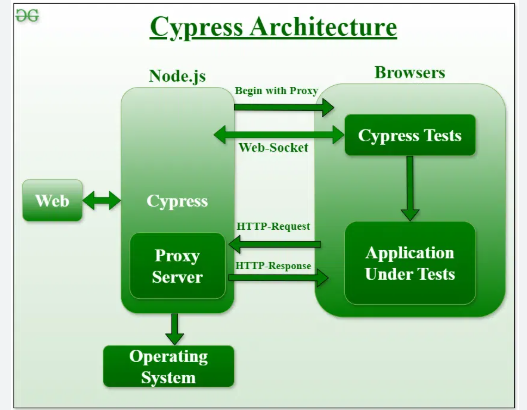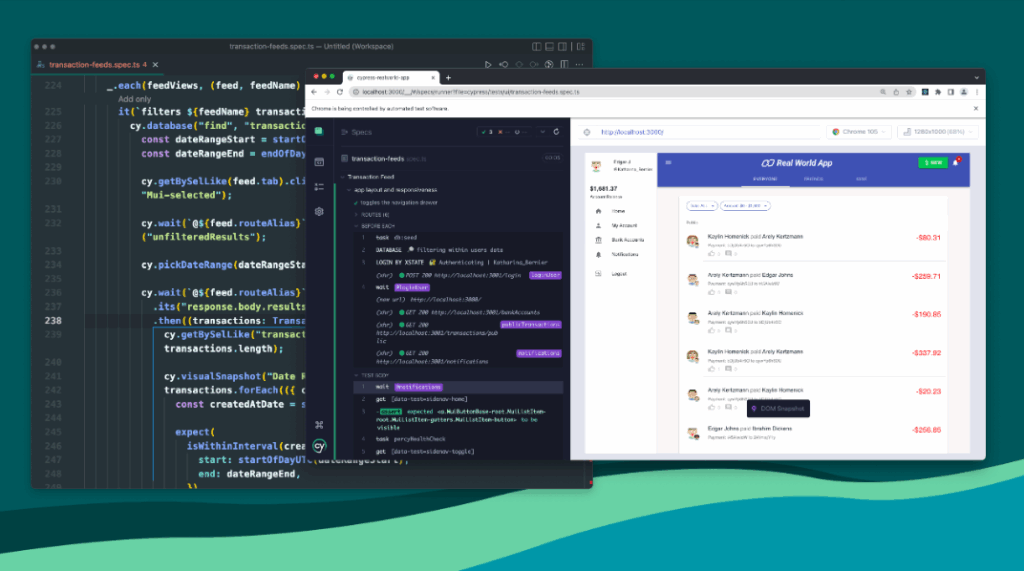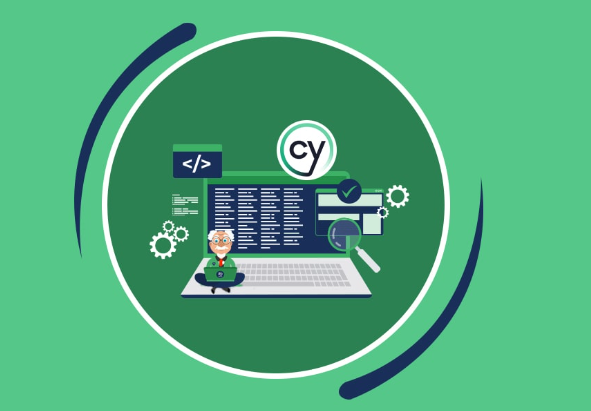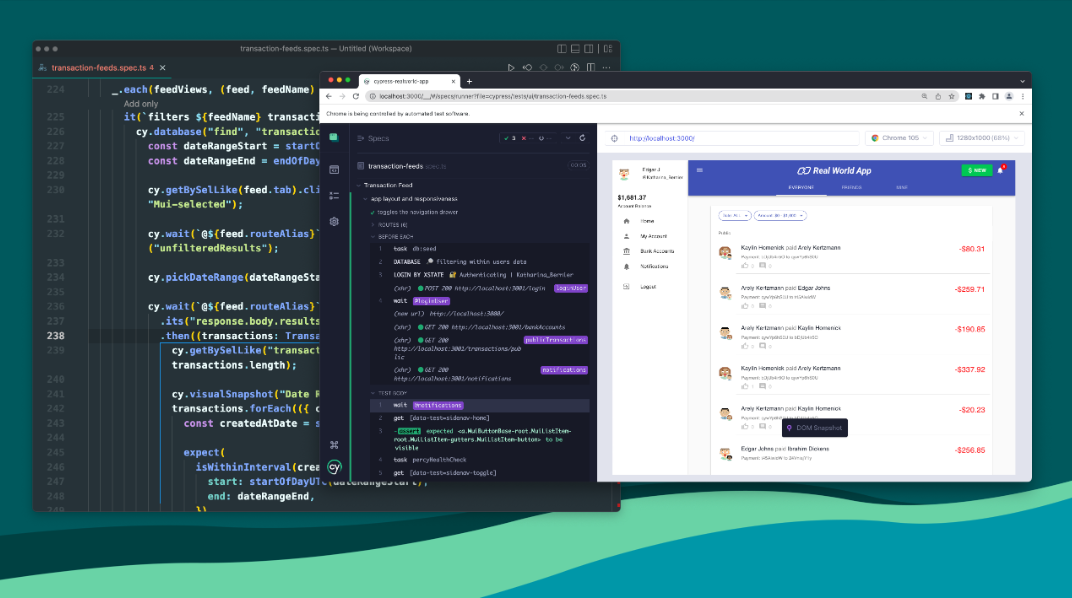
Automated Testing With Cypress Course in Visakhapatnam | Multiple courses are available for automated testing with Cypress, ranging from beginner-friendly introductions to comprehensive, “zero-to-hero” bootcamps covering advanced topics. Top options can be found on platforms and specialized training sites.
Coursera Project Network: Cypress UI automation testing for absolute beginners
Focus: Automated Testing With Cypress Course in Visakhapatnam | A hands-on, guided project that allows you to learn and practice Cypress basics simultaneously.
Key Topics: Cypress architecture and setup, writing your first test, locating elements, and using assertions.
What to look for in a Cypress course
- Project-based learning: Automated Testing With Cypress Course in Visakhapatnam | Courses that involve building a real framework from scratch offer practical, hands-on experience.
- CI/CD Integration: Advanced courses should cover how to integrate Cypress with tools like Jenkins or GitHub Actions to automate test execution.
- API testing: Some courses will teach you how to use Cypress to test REST APIs in addition to the UI.
- BDD with Cucumber: For behavior-driven development, look for courses that integrate Cucumber with Cypress.
- JavaScript basics: Automated Testing With Cypress Course in Visakhapatnam | Since Cypress is a JavaScript framework, some courses, especially those for beginners, include a module on JavaScript fundamentals.
- Support and community: Some platforms, like Udemy and specialized trainers, offer lifetime access to materials, Q&A sections, and support for your learning journey.
Automated Testing With Cypress Course in Visakhapatnam | Of course. Here is a comprehensive and structured outline for an Automated Testing with Cypress Course, designed to take a student from zero to a proficient test automation engineer.
Course Title: End-to-End Test Automation Mastery with Cypress
Target Audience: Automated Testing With Cypress Course in Visakhapatnam | Manual testers, QA engineers, software developers, SDETs (Software Development Engineers in Test), and anyone who wants to learn modern, reliable, and fast web test automation.
Prerequisites:
- Basic understanding of how web applications work (HTML, CSS, JavaScript).
- Fundamental knowledge of JavaScript (variables, functions, objects, arrays). The course will include a JS refresher.
- No prior test automation experience is required.
Course Goal: Automated Testing With Cypress Course in Visakhapatnam | To equip students with the skills to write, run, and debug robust, maintainable, and fast end-to-end (E2E) and component tests for modern web applications using the Cypress.io framework.

Detailed Course Modules
Module 1: Introduction to Modern Test Automation
- 1.1 The “Why” of Automation: Automated Testing With Cypress Course in Visakhapatnam | The importance of automated testing for speed, reliability, and continuous integration.
- 1.2 Cypress vs. Selenium: Understanding the architectural differences and why Cypress is a game-changer (no WebDriver, native access, built-in async handling).
- 1.3 Cypress Ecosystem: Overview of Cypress Test Runner, Dashboard Service, and Studio.
- 1.4 Setting Up Your Environment: Automated Testing With Cypress Course in Visakhapatnam | Installing Node.js, npm, and Cypress. Creating your first project.
Module 2: Cypress Fundamentals & The Test Runner
- 2.1 Anatomy of a Test: Structure of a test suite (
describeblock) and a test case (itblock). - 2.2 The Magic of the Cypress Test Runner: Deep dive into the interactive GUI: command log, DOM snapshot, console, and viewport management.
- 2.3 Writing Your First Test: Visiting a page and making a simple assertion.
- 2.4 Debugging 101: Using
cy.pause()and.debug()to understand what’s happening in your tests.
Module 3: JavaScript Refresher for Cypress
- 3.1 Arrow Functions & Callbacks: Understanding the syntax used throughout Cypress.
- 3.2 Promises and Async/Await: Demystifying asynchronous behavior. How Cypress handles promises under the hood so you don’t have to.
- 3.3 Mocha & Chai: Understanding the BDD syntax provided by these built-in libraries for structuring tests and making assertions.
Module 4: Interacting with Web Elements
- 4.1 Selectors Strategy: Best practices for selecting elements. Using
data-*attributes (e.g.,data-cy="submit-btn") for resilience. - 4.2 Core Commands:
- Actions:
.click(),.type(),.clear(),.check(),.select() - Traversal:
.find(),.parent(),.siblings(),.within() - Assertions:
.should(),.and(),.expect()for validating text, classes, CSS, values, and state (visible, disabled, exist).
- Actions:
- 4.3 Handling Common UI Elements: Dropdowns, radio buttons, checkboxes, iframes.
Module 5: Advanced Interactions & Waiting Strategies

- 5.1 The Cypress Execution Queue: Understanding how commands are enqueued and run asynchronously.
- 5.2 Built-in Retry-ability: Automated Testing With Cypress Course in Visakhapatnam | The most powerful feature. How Cypress automatically waits for elements and assertions without needing explicit
sleepcommands. - 5.3 Network Wait Strategies: Waiting for specific API calls to complete using
cy.intercept()andcy.wait(). - 5.4 Dealing with Non-Standard Elements: Forceful actions (e.g.,
{force: true}) and when to use them sparingly.
Module 6: Stubbing and Mocking with cy.intercept()
- 6.1 Introduction to
cy.intercept(): Controlling, spying on, and stubbing network requests (XHR and Fetch). - 6.2 Spying on Requests: Validating that a request was made with the correct payload.
- 6.3 Mocking (Stubbing) Responses: Returning fake static or dynamic data to test application behavior without relying on a slow or unreliable backend.
- 6.4 Simulating Errors: Mocking network errors (500, 404, etc.) to test error handling in the UI.
- 6.5 Fixtures: Using
cy.fixture()to load static test data from JSON files for mocking.
Module 7: Organizing Tests & Best Practices
- 7.1 Configuration (
cypress.config.js): Setting base URLs, timeouts, and environment variables. - 7.2 Custom Commands: Creating reusable commands for common actions (e.g.,
cy.login(),cy.addToCart()) to avoid code duplication. - 7.3 Page Object Model (POM) Pattern: Organizing selectors and actions into reusable page classes for better maintainability.
- 7.4 Hooks: Using
before(),beforeEach(),after(), andafterEach()for test setup and teardown.
Module 8: Advanced Topics & Debugging
- 8.1 Cross-Origin Testing: Handling navigation to different domains.
- 8.2 File Uploads and Downloads: Strategies for testing these tricky operations.
- 8.3 Visual Testing (Intro): Using third-party plugins like Applitools or Percy for visual regression testing.
- 8.4 Advanced Debugging: Using the browser’s Developer Tools alongside the Cypress Test Runner.
Module 9: Continuous Integration (CI) & Reporting

- 9.1 Running Cypress Headlessly: Automated Testing With Cypress Course in Visakhapatnam | Using
cypress runfor command-line execution. - 9.2 Integrating with CI/CD Pipelines: Configuring Cypress to run in GitHub Actions, GitLab CI, Jenkins, etc.
- 9.3 Generating Reports: Using plugins like
mochawesometo generate beautiful HTML test reports. - 9.4 Cypress Dashboard Service (Overview): Using the paid service for recording test runs, parallelization, and flake detection.
Module 10: Component Testing (Optional but Powerful)
- 10.1 What is Component Testing? Testing individual UI components in isolation (e.g., React, Vue, Svelte components).
- 10.2 Setting Up Component Testing: Configuring Cypress for your front-end framework.
- 10.3 Mounting Components: Using
cy.mount()to render a component and test its interactions and state changes directly.
Module 11: Capstone Project
- Students will write a complete test suite for a demo web application (e.g., a todo app, an e-commerce site).
- Requirements:
- Write tests for critical user journeys (e.g., user registration, login, adding items to a cart, checkout).
- Implement the Page Object Model for organization.
- Use custom commands for common workflows.
- Mock all API responses using
cy.intercept()and fixtures. - Configure the project to run in headless mode and generate a report.
- The final deliverable is a GitHub repository with the complete, well-documented test suite.
Recommended Tools & Technologies
- Framework: Cypress.io (latest version)
- Language: JavaScript
- Package Manager: npm or yarn
- Code Editor: Visual Studio Code (with Cypress helper extensions)
- Version Control: Git & GitHub
- CI/CD: GitHub Actions (free for public repos)
Learning Outcomes

Upon completion, students will be able to:
- Explain the fundamental architecture and advantages of Cypress over other testing tools.
- Write reliable end-to-end tests for complex user interactions on modern web applications.
- Effectively use the Cypress Test Runner to write and debug tests in real-time.
- Control network behavior by stubbing and mocking API responses for fast and reliable tests.
- Implement scalable patterns like Custom Commands and the Page Object Model.
- Integrate Cypress into a CI/CD pipeline to run tests automatically on every code change.
- Understand and apply component testing for front-end frameworks.
- Build a maintainable and robust test automation framework from the ground up.
This curriculum is intensely hands-on. Automated Testing With Cypress Course in Visakhapatnam | The best way to learn Cypress is by writing tests, and the course is designed with numerous practical labs and a significant capstone project to ensure students gain the confidence and portfolio to excel in a professional role.
Ventajas de Utilizar Cypress en Pruebas de Software: Enfoque en Automatización
Automated Testing With Cypress Course in Visakhapatnam | En un mundo empresarial cada vez más impulsado por la tecnología, las pruebas de software se han convertido en un componente crítico para garantizar la calidad y el éxito de las aplicaciones. En este contexto, emerge Cypress revolucionando la forma en que se abordan las pruebas de software en el desarrollo de aplicaciones modernas.
En este artículo, exploraremos cómo Cypress proporciona ventajas significativas en términos de calidad y eficiencia en las pruebas de software.
Automated Testing With Cypress Course in Visakhapatnam | Cypress es una herramienta de pruebas automatizadas de código abierto que se destaca en el desarrollo de aplicaciones web modernas. Ofrece un enfoque integral que abarca desde un framework de pruebas hasta una biblioteca de aserciones, todo esto sin la necesidad de Selenium u otras herramientas complicadas.
Características Destacadas de Cypress:

● Sintaxis Clara y Documentación Amplia: Cypress se destaca por su sintaxis clara y su amplia documentación. Esto la hace accesible incluso para aquellos nuevos en las pruebas automatizadas.
● Capacidad en Tiempo Real: Una de las ventajas más notables de Cypress es su capacidad en tiempo real. Los desarrolladores pueden ver las pruebas en ejecución, lo que permite identificar y solucionar problemas de inmediato.
● Automated Testing With Cypress Course in Visakhapatnam | Versatilidad Tecnológica: Cypress es altamente adaptable y es compatible con una variedad de tecnologías, convirtiéndola en una elección versátil para proyectos de desarrollo web.
En conjunto, estas características hacen que Cypress sea una herramienta valiosa y completa para mejorar la calidad del software en el desarrollo de aplicaciones web.

La elección de Cypress como herramienta de pruebas automatizadas presenta diversas ventajas:
1. Eficiencia en las Pruebas: Cypress permite crear y ejecutar pruebas de extremo a extremo de manera eficiente. Esto acelera la identificación y resolución de problemas durante el desarrollo y reduce la probabilidad de errores.
2. Automated Testing With Cypress Course in Visakhapatnam | Facilita las Pruebas de Integración: Cypress simplifica las pruebas de integración, garantizando la coherencia en el funcionamiento del sistema y evitando conflictos entre nuevas y existentes características.
3. Mejora la Calidad del Producto: Las pruebas automatizadas con Cypress garantizan la alta calidad de cada versión del software, proporcionando una experiencia de usuario fiable y satisfactoria.
4. Automated Testing With Cypress Course in Visakhapatnam | Soporte para Pruebas en Diferentes Navegadores: Cypress brinda soporte para pruebas en una amplia gama de navegadores, asegurando una experiencia consistente para todos los usuarios.
5. Automated Testing With Cypress Course in Visakhapatnam | Mayor Productividad del Desarrollador: Con Cypress, los desarrolladores pueden crear y ejecutar pruebas automatizadas de manera más eficiente, lo que les permite dedicar más tiempo a la creación de código y menos a tareas manuales repetitivas de pruebas. Esto agiliza el proceso de desarrollo en general y acelera la entrega del producto final.
6. Visibilidad y Depuración Mejoradas: Cypress ofrece una interfaz de usuario que permite a los desarrolladores observar las pruebas en tiempo real, facilitando la identificación y solución de problemas.
7. Integración con Herramientas de CI/CD: Cypress se integra fácilmente con sistemas de integración continua (CI) y entrega continua (CD), automatizando las pruebas en el ciclo de desarrollo.
8. Automated Testing With Cypress Course in Visakhapatnam | Compatibilidad con Aplicaciones de una Única Página (SPA): Cypress está diseñado para trabajar eficazmente con aplicaciones de una sola página (SPA).

9. Comunidad Activa: Cypress cuenta con una comunidad activa de desarrolladores que asegura que la herramienta esté actualizada y sea compatible con las últimas tecnologías.
Automated Testing With Cypress Course in Visakhapatnam | Podemos decir, que Cypress se destaca como una herramienta esencial para mejorar la calidad del software en el desarrollo de aplicaciones web modernas. Su adopción no solo garantiza la excelencia en las pruebas de software, sino que también impulsa la eficiencia y la productividad en todo el ciclo de desarrollo. Cypress se erige como un aliado indispensable en la búsqueda de aplicaciones de alta calidad que satisfagan las necesidades de usuarios y empresas en la era digital.




